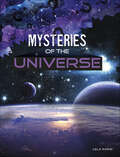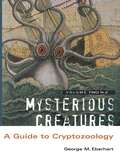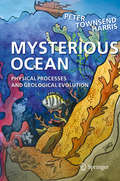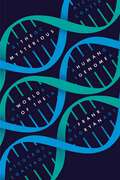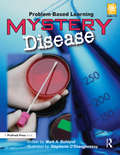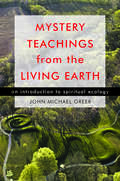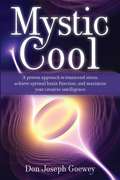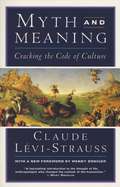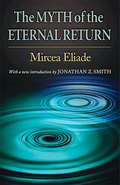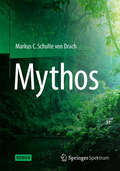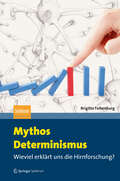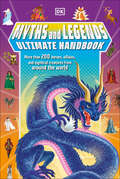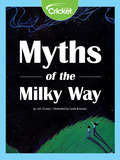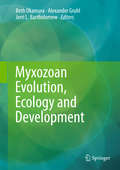- Table View
- List View
Mysteries of the Universe (Solving Space's Mysteries)
by Lela NargiHas the universe always existed? Scientists have looked further into space and discovered the galaxies moving. Were they once closer together? If scientists look far enough, can they discover where our universe started? Budding astronomers will learn all about the universe in this in-depth look at space science.
Mysterious Creatures: A Guide To Cryptozoology, Volume 1
by George M. EberhartIn the hi-tech, industrialised world of the 21st Century, monsters still loom large. Far from being relegated to the realm of myth and legend, mysterious creatures seem to be alive and well today. <p><p>In this, the first of two volumes, acclaimed researcher George M. Eberhart provides a comprehensive list of the creatures that roam our monster-haunted planet. Covering 'A-M', Volume One tackles some well-known beasts as well as more esoteric creatures few will have heard of.
Mysterious Creatures: A Guide To Cryptozoology, Volume 2
by George M. EberhartIn the hi-tech, industrialised world of the 21st Century, monsters still loom large. Far from being relegated to the realm of myth and legend, mysterious creatures seem to be alive and well today. <p><p>In this, the second of two volumes, acclaimed researcher George M. Eberhart provides a comprehensive list of the creatures that roam our monster-haunted planet. Covering 'N-Z', Volume Two tackles some well-known beasts as well as more esoteric creatures few will have heard of.
Mysterious Migrations (Fountas & Pinnell LLI Purple #Level Q)
by Terry Miller ShannonText Elements <p><p> Genre: Expository/Biography <p> Text Structures <p> Main: Chronological Sequence <p> Embedded: Description, Problem/Solution, Cause/Effect <p> Text Features: table of contents, headings, photos, captions, map, sidebars
Mysterious Ocean: Physical Processes and Geological Evolution (Springer Oceanography Ser.)
by Peter Townsend HarrisThis book provides an introduction to ocean sciences that is engaging, evocative and accessible to non-experts interested in marine geoscience, while sparking readers' interest in important unsolved mysteries in marine science. The scope of the book is quite broad, but focuses on the physical ocean and its geological evolution, including the author's experiences working as an oceanographer over the last thirty years. Across ten chapters, the book traces the origins of the ocean from its formation 4 billion years ago, reviews the discoveries of the theory of plate tectonics, the ice ages and the great ocean conveyor, and discusses seafloor features (canyons, seamounts, trenches, abyssal plains, etc.), how they formed and their current environmental issues. The book concludes with a prognosis for the future ocean we might expect with global climate change and other human impacts.
Mysterious Patterns: Finding Fractals in Nature
by Sarah C. CampbellNature's repeating patterns, better known as fractals, are beautiful, universal, and explain much about how things grow. Fractals can also be quantified mathematically. Here is an elegant introduction to fractals through examples that can be seen in parks, rivers, and our very own backyards. Young readers will be fascinated to learn that broccoli florets are fractals—just like mountain ranges, river systems, and trees—and will share in the wonder of math as it is reflected in the world around us. Perfect for any elementary school classroom or library, Mysterious Patterns is an exciting interdisciplinary introduction to repeating patterns.
Mysterious World of the Human Genome
by Frank RyanThe human genome is indeed a mysterious world, but, as this fascinating book shows, its vital secrets are now being uncovered. The latest studiesare revealing exciting new discoveries, such as how the DNA and related chemical compounds in our cells work together to direct the processes of life. Scientists are not only unraveling how life evolved in the ancient past, but are also finding the keys to creating a healthier future. How does the minuscule chemical cluster in each of our 100 trillion cells accomplish the amazing feat of creating and maintaining our bodies? Frank Ryan, a physician and an evolutionary biologist, describes the complex ways in which the genome operates as a holistic system and not solely through genes coding for proteins-the building blocks of life. Also involved are elaborate switching mechanisms that regulate and control portions of our DNA, as well as the interplay of retroviruses and bacteria. This groundbreaking book explains thatwe are on the cusp of an amazing era of disease treatment and eradication.
Mystery Disease: Problem-Based Learning (Grades 5-8)
by Mark A. BohlandA serious illness is sweeping through town. Why are people getting sick? What is the source of this disease? With this problem-based learning unit, students become public health workers as they track down the source of a mysterious illness. Working in teams to solve the real-world problem and present their findings, they experience genuine, higher order learning. Decisions they make affect the outcome of the simulation.The activities combine science, social studies, math, research, thinking, cooperation, and speech skills in one great unit. This guide includes everything you need—teacher's directions and student information in the form of memos and medical reports.This open-ended scenario will draw students into a real-life drama.Allow your students to solve more real-life problems in Crime Scene Detective, Detective Club, Mystery Science, and The Great Chocolate Caper.Grades 5-8
Mystery Teachings from the Living Earth: An Introduction to Spiritual Ecology
by John Michael GreerThe authentic mystery teachings are not about quick fixes or easy answers. They offer something far deeper and more meaningfulùa path of personal transformation in harmony with the cosmos on all its levels, from the ultimate heights of spirit to the fragile and beautiful planet on which we live. In Mystery Teachings from the Living Earth, ecologist and Druid initiate John Michael Greer offers an introduction to the core teachings of the mysteries through the mirror of the natural world.
Mystery of the Ashen Light of Venus: Investigating a 400-Year-Old Phenomenon (Astronomers' Universe)
by John C. BarentineThe “Ashen Light” of Venus—a ghostly emission of light from the night side of our nearest planetary neighbor—is among the last unsolved mysteries of astronomical history. In the four centuries since the phenomenon was first reported, highly reputable visual observers of Venus have recorded seeing the Ashen Light, while others have spent a lifetime searching for it without once being convinced that they ever saw it. Is the Ashen Light a trick of the eye? The result of a defective lens? A real scientific event? Occasional references to the Ashen Light are scattered across the literature, yet no work to date has synthesized these records. This book therefore digs deep into the history of the mystery and our latest attempts to understand it, sifting through the clues that might explain whether it is caused by physics, is conjured up by the eye or brain, or a combination of both. This baffling story will appeal to amateur astronomers, hobbyists, and lay readers interested in joining the debate about one of the most elusive observable phenomena ever recorded in the night sky.
Mystic Cool: A proven approach to transcend stress, achieve optimal brain function, and maximize your creative intelligence.
by Don Joseph GoeweyYou possess the most remarkable system in all of biology, the human brain. You have the power to direct it with the most complex set of processes in the universe, the mind. When you use this creative power consciously, you not only actualize the power to excel in whatever you do, you can direct your experience in ways that make life fulfilling and meaningful. As wonderful as this might sound, for many the journey may be anything but. Every major survey shows that the majority of us are plagued by stress and anxiety, which is toxic to the brain. The new science is clear: transcend stress, regain higher brain function, and the mind lights up with creative intelligence. Mystic Cool shows us how to calmly turn our backs on stress and walk in the direction of the brilliant life we were born to live.
Myth and Meaning
by Claude Levi-StraussIn these five lectures, distinguished social anthropologist offers the insights of a lifetime spent interpreting myths and trying to discover their significance for human understanding. This textbook tries to bridge the gap between myth and science. table end
Myth and the Human Sciences: Hans Blumenberg's Theory of Myth (Theorists of Myth)
by Angus NichollsThis is the first book-length critical analysis in any language of Hans Blumenberg’s theory of myth. Blumenberg can be regarded as the most important German theorist of myth of the second half of the twentieth century, and his Work on Myth (1979) has resonated across disciplines ranging from literary theory, via philosophy, religious studies and anthropology, to the history and philosophy of science. Nicholls introduces Anglophone readers to Blumenberg’s biography and to his philosophical contexts. He elucidates Blumenberg’s theory of myth by relating it to three important developments in late nineteenth- and early twentieth-century German philosophy (hermeneutics, phenomenology and philosophical anthropology), while also comparing Blumenberg’s ideas with those of other prominent theorists of myth such as Vico, Hume, Schelling, Max Müller, Frazer, Sorel, Freud, Cassirer, Heidegger, Horkheimer and Adorno. According to Nicholls, Blumenberg’s theory of myth can only be understood in relation to the ‘human sciences,’ since it emerges from a speculative hypothesis concerning the emergence of the earliest human beings. For Blumenberg, myth was originally a cultural adaptation that constituted the human attempt to deal with anxieties concerning the threatening forces of nature by anthropomorphizing those forces into mythic images. In the final two chapters, Blumenberg’s theory of myth is placed within the post-war political context of West Germany. Through a consideration of Blumenberg’s exchanges with Carl Schmitt, as well as by analysing unpublished correspondence and parts of the original Work of Myth manuscript that Blumenberg held back from publication, Nicholls shows that Blumenberg’s theory of myth also amounted to a reckoning with the legacy of National Socialism.
Myth of the Eternal Return: Cosmos and History
by Mircea Eliade Willard R. TraskThis founding work of the history of religions, first published in English in 1954, secured the North American reputation of the Romanian émigré-scholar Mircea Eliade (1907-1986). Making reference to an astonishing number of cultures and drawing on scholarship published in no less than half a dozen European languages, Eliade's The Myth of the Eternal Return makes both intelligible and compelling the religious expressions and activities of a wide variety of archaic and "primitive" religious cultures. While acknowledging that a return to the "archaic" is no longer possible, Eliade passionately insists on the value of understanding this view in order to enrich our contemporary imagination of what it is to be human. Jonathan Z. Smith's new introduction provides the contextual background to the book and presents a critical outline of Eliade's argument in a way that encourages readers to engage in an informed conversation with this classic text.
Mythbusters: Confirm or Bust! Science Fair Book #2
by Samantha MarglesThis fun follow-up book to the successful MythBusters Science Fair Book is packed with more than thirty brand-new experiments for school and at home.
Mythopedia: A Brief Compendium of Natural History Lore (Pedia Books)
by Adrienne MayorFrom acclaimed folklorist and historian Adrienne Mayor, an enchanting collection of the ancient myths that emerged out of the wonders—and disasters—of the natural worldMythopedia is a fun, fact-filled A-Z treasury of myths inspired by natural events. Bringing together fifty legends from antiquity to the present, this delightfully entertaining book takes you around the world to explore sunken kingdoms and lost cities, accursed mountains and treacherous terrains, and lethal lakes and singing sand dunes, explaining the historical background and latest science underlying each tale.As soon as humans invented language, they told stories to explain mysterious things they observed around them—on land, in the seas, and in the skies. Even though these tales are expressed in poetic or supernatural language, they contain surprisingly accurate insights and even eyewitness descriptions of catastrophic events millennia ago. Drawing on her unique insights as a pioneer in the exciting new field of geomythology, Adrienne Mayor describes how cultural memories of tsunamis, volcanic disasters, and other massive geological events can reach back thousands of years as the stories were preserved, elaborated, told, and retold across generations. She shows how geomythology is expanding our understanding of our planet&’s history over eons, revealing the human desire to explain nature and weave imaginative stories intertwined with keen observation, rational speculation, and memory.With captivating drawings by Michele Angel, Mythopedia is a compendium of many marvels, from the Hindu monkey god Hanuman and his army of bridge-building primates to the terrifying sand demon Shensha shen of China, the gnawing glaciers of Austria, and the vengeful fish-headed snake god Nyami Nyami of Africa&’s Zambezi River.Features a cloth cover with an elaborate foil-stamped design
Mythos
by Markus C Schulte von DrachEine Expedition ins Herz des Dschungels. Eine Reise an den Anfang und das Ende des Glaubens. Eine abenteuerliche Auseinandersetzung mit der Religion und der Evolution. Im Jahr 1539 begegnet der spanische Konquistador Juan de la Torre im Amazonasdschungel dem Teufel. Als fast 500 Jahre später die deutsche Schriftkundlerin Nora Tilly im Indienarchiv von Sevilla auf Dokumente des Spaniers stößt, entdeckt sie Hinweise auf einen Inka-Schatz. Doch bald muss sie feststellen, dass sie nicht die einzige ist, die sich auf den Weg macht, um das Gold zu finden. Die irische Journalistin Brea MacLoughlin reist mit einer Delegation katholischer Geistlicher ebenfalls nach Peru, um ein angebliches Wunder in den Anden zu überprüfen. Zu dieser Delegation gehört auch der junge Priester Arnaud d'Albret, der in Südamerika über eine ihm verbotene Liebe hinwegzukommen hofft. Nach dem gewaltsamen Tod seines Mentors schließt d'Albret sich Nora Tilly an. Auch Brea MacLoughlin folgt der Expedition der Schatzsucher. Im Dschungel Perus entdeckt unterdessen der Biologiestudent Francisco Pérez etwas, das eigentlich nicht existieren dürfte: das fünfzehn Millionen Jahre alte Fossil eines Riesenkrokodils, in dessen Schädel eine Pfeilspitze steckt. Der Versuch, dieses Rätsel zu lösen, führt ihn schließlich mit den Schatzjägern aus Europa zusammen. Doch was die Expedition im Dschungel erwartet, ist nicht nur das Gold der Inka. Tief im Wald stoßen sie auf etwas, das ihr Weltbild in Stücke reißt. ......... "Eine abenteuerliche Melange aus Dawkins' Gotteswahn, Indiana Jones und Jurassic Park. Schulte von Drach gelingt, was Dan Brown nie schaffte: den Leser zu fesseln, ohne seinen Verstand zu lähmen. Absolut empfehlenswert!" Michael Schmidt-Salomon, Philosoph und Schriftsteller, Vorstandssprecher der Giordano-Bruno-Stiftung, Autor von "Jenseits von Gut und Böse" "Wie viel Menschenwerk steckt in der Religion? Im Unterschied zum ätzenden Stil neoatheistischer Gotteswahn-Polemik setzt dieses Buch auf eine Strategie à la Umberto Eco: Der Reigen religionskritischer Überlegungen ist eingepackt in eine Rahmenhandlung, deren Spannung - Science-Fiction und Thriller im besten Sinn - den Leser mitnimmt zu den Etappen der intellektuellen Auseinandersetzung." Christian Kummer, Biologe, Philosoph und Jesuit, Professor an der Hochschule für Philosophie in München, Autor von "Der Fall Darwin" _____ Terra X und Theodizee, Evolution und El Dorado, Schatzjagd und Gottessuche - Markus C. Schulte von Drachs neuer Roman entführt Sie auf eine abenteuerliche Reise um die halbe Welt und zurück bis ins 16. Jahrhundert: Von Sevilla, Kismayoo, Florida und Iquitos aus machen sich seine Helden auf den Weg ins Herz des Amazonas-Regenwaldes. Auf der Suche nach dem legendären Inka-Gold, einem unglaublichen Fossil und ihrem Seelenfrieden stoßen ein französischer Priester, eine deutsche Schatzjägerin, eine irische Journalistin, ein peruanischer Biologiestudent und ein türkischer Kreationist auf die Spuren des Matararo. Doch gibt es dieses Wesen überhaupt? Lassen Sie sich von den Abenteuern genauso fesseln wie von den Auseinandersetzungen über Religion und Wissenschaft, die diesen Thriller so außergewöhnlich machen. Folgen Sie den unterschiedlichen Persönlichkeiten auf ihrem Weg, bis am Ende alle gemeinsam vor einer einzigen Aufgabe stehen: zu überleben.
Mythos Determinismus
by Brigitte FalkenburgAus Sicht von Neurobiologen regiert das neuronale Geschehen im Kopf unser Bewusstsein. Als Physikerin und Philosophin hinterfragt die Autorin in diesem Buch die Aussagen von Hirnforschern und stellt fest, dass die Neurobiologie an längst überholten mechanistischen Vorstellungen festhält und dadurch zu Fehlschlüssen über den menschlichen Geist und den freien Willen gelangt. Der Band liefert die Grundzüge einer Wissenschaftstheorie der Hirnforschung und weist damit den Weg zu einem differenzierteren Naturverständnis und Menschenbild.
Mythos Determinismus: Wieviel erklärt uns die Hirnforschung?
by Brigitte FalkenburgAus der Sicht der Neurobiologie regiert im Kopf das neuronale Geschehen. Doch was wissen die Hirnforscher genau über die Mechanismen des Hirngeschehens und ihren Einfluss auf den menschlichen Geist? Dieser Frage geht Brigitte Falkenburg nach. Die Physik hat sich längst vom mechanistischen Weltbild gelöst, in der Neurobiologie bleiben überholte mechanistische Vorstellungen bis heute wirksam. Dabei sind die "mechanistischen" Erklärungen der Hirnforschung ganz anders als ihr Name suggeriert; und wer annimmt, der Geist sei so strukturiert wie die Materie, zieht atomistische und kausale Fehlschlüsse über das Bewusstsein. Falkenburgs Buch möchte die Debatte um Geist und Gehirn, freien Willen und Determinismus endlich davon befreien. Es liefert Grundzüge einer Wissenschaftstheorie der Hirnforschung und eröffnet den Weg zu einem differenzierteren Naturverständnis und Menschenbild. Das beliebte Sachbuch ist für die zweite Auflage vollständig überarbeitet und aktualisiert worden.
Myths and Legends Ultimate Handbook: More than 200 Heroes, Villains and Mythical Creatures from Around the World (DK's Ultimate Handbook)
by Ben HubbardDiscover the amazing myths and legends surrounding gods, goddesses, magical creatures, heroes, and monsters from around the world.This fact-packed title in DK’s Ultimate Handbook series is a treasure trove of narratives on more than 200 fascinating myths and legends.Children aged 5-9 can learn all about the origin of different legends, the unique characteristics of powerful gods and goddesses and a wide variety of mythical creatures. With intriguing stories of notorious tricksters, mighty winged creatures, and heroic battles, this book is loaded with beautiful photography and authentic text from subject experts.This myths and legends book for kids offers: 200 stories of myths, legends, and folklore from around the world and their origins.A global approach to myths and legends, covering stories from Europe, Asia, the Americas, Africa, and Oceania.An engaging handbook style for a deep dive into the subject through an informal tone.Step into the fascinating world of myths with DK’s Myths and Legends Ultimate Handbook and read about fearsome battles between monsters, such as the Hydra and Fafnir the dragon, and the heroes that fought them like Hercules and Sigurd. Find out about the exciting legends of King Arthur and Sun Wukong, and get to know about epics, such as the Mahabharata, Popol Vuh, and a host of tales from around the world.At DK, we believe in the power of discovery. So why not complete the collection?DK's Ultimate Handbook series will spark curiosity and amaze children aged 5+ interested in the world around them. Travel back to the prehistoric world with Dinosaur Ultimate Handbook, explore the incredible animal kingdom with Animal, and unearth the natural world with Rocks and Minerals.
Myths of the Milky Way
by Linda Bronson Jim O'LearyOver time, cultures from around the world have given us many different myths about our home galaxy. When you look up at the sky at night, what stories would you tell about what you see?
Myths, Models and Paradigms
by Ian G. BarbourScientist and philosophers have more in common than might first appear, especially when the language used in the two disciplines receives a closer scrutiny. Ian G. Barbour treats three scientific view-points that can clarify the specific nature of religious language. The first theme is the diverse function of language. Science and religion each has its own task and its own applicable logic and language. Religious symbols and their expression in myths imply a perspective and interpretation of human history and experience, directing attention to particular patterns in events. The second theme is the role of models in both scientific and religious language. What the "billiard ball model" of a gas and the biblical model of personal God both achieve is an interpretation of experience, a restructuring of how one sees the world. The third area in which science and religion have a common stake is the role of paradigms. Paradigms are standard examples of scientific investigation which embody a set of assumptions and becomes a research tradition until replaced by other assumptions. Religions has its paradigms, like the covenant of Sinai, which have issued in traditions. Dr. Barbour concludes that scientific and religious language bother offer knowledge of reality based on experience. In determining the appropriate data and criteria for this experience the philosopher of religion can profit greet from the work of the scientist.
Myxozoan Evolution, Ecology and Development
by Beth Okamura Alexander Gruhl Jerri L. BartholomewThis book provides an up-to-date review of the biology of myxozoans, which represent a divergent clade of endoparasitic cnidarians. Myxozoans are of fundamental interest in understanding how early diverging metazoans have adopted parasitic lifestyles, and are also of considerable economic and ecological concern as endoparasites of fish. Synthesizing recent research, the chapters explore issues such as myxozoan origins; evolutionary trends and diversification; development and life cycles; interactions with hosts; immunology; disease ecology; the impacts of climate change on disease; risk assessment; emerging diseases; and disease mitigation. This comprehensive work will appeal to a wide readership, from invertebrate zoologists, evolutionary biologists and developmental biologists to ecologists and parasitologists. It will also be of great practical interest to fisheries and conservation biologists. The identification of key areas for future research will appeal to scientists at all levels.
M² Models and Methodologies for Community Engagement
by Dianne Smith Marina Lommerse Reena TiwariHow can we engage communities? What is empowerment? To what extent should the project process be participatory? How is an outsider-insider relationship handled? How do researchers negotiate with the hegemony of western cultural interpretations? How are organizational and contextual influences handled in a project? What leadership demands do such projects place on researchers? What is capacity building? What are creative leaders and creative communities? How does the researcher journey from their studio to the situation? M² Models and Methodologies for Community Engagement discusses key theoretical constructs -- community engagement, capacity building, and community empowerment -- in order to demonstrate how theory and practice are relevant to the development of forms of community involvement. The book maps the attributes of community based projects by moving beyond simply bringing people together from a variety of disciplines, and taking an approach which is transdisciplinary and applicable across cultures and genres. Here, all people -- including the community -- are ongoing contributors, and can freely move between their own and others' discipline-specific arenas. M² differs from and extends on other works in this field of practice and research, in that its transdisciplinary, collaborative approach positions the community as a particular kind of discipline to create real change in diverse locations and fields of experience. The book is in itself a model of community engagement, as the researchers have formed a community of research and practice for change, and have developed a transformative model for community engagement that is greater than the sum of its parts - hence M². M² offers a valuable resource for students, researchers, academics, practitioners, policy developers and volunteers from the fields of architecture, interior architecture, health, planning, anthropology, education, home economics, communication, political studies and development studies.
